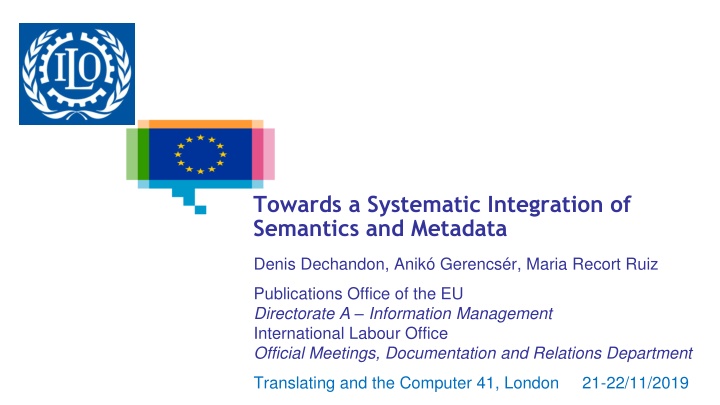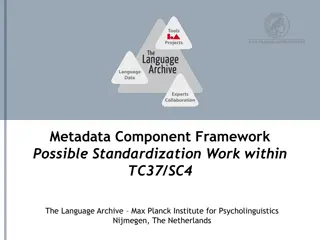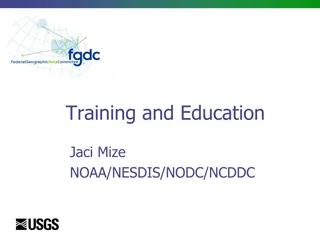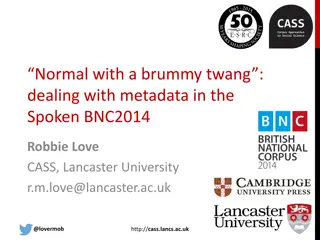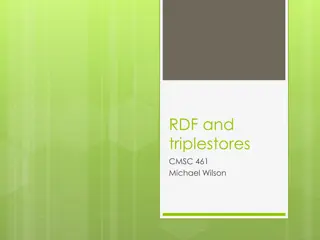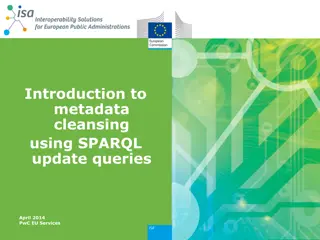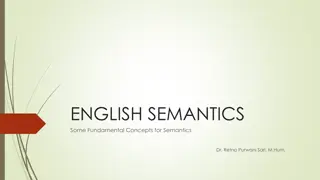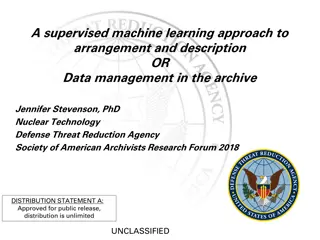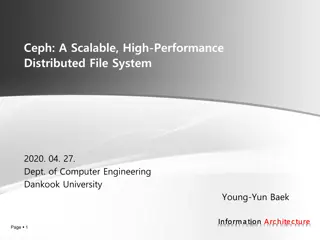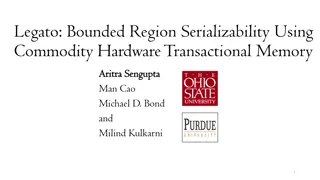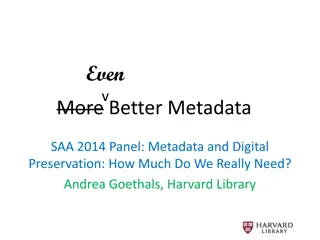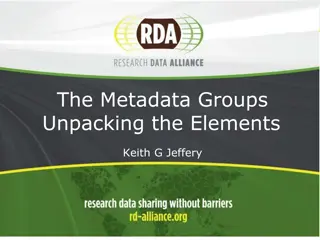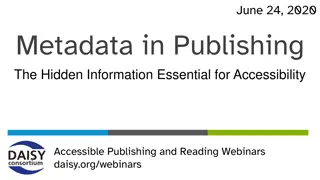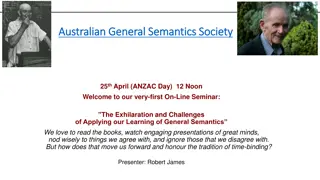Towards a Systematic Integration of Semantics and Metadata
The content discusses challenges, objectives, technologies, and standards related to knowledge sharing, emphasizing the importance of semantic web and controlled vocabularies in facilitating multilingual drafting and information retrieval.
Download Presentation

Please find below an Image/Link to download the presentation.
The content on the website is provided AS IS for your information and personal use only. It may not be sold, licensed, or shared on other websites without obtaining consent from the author.If you encounter any issues during the download, it is possible that the publisher has removed the file from their server.
You are allowed to download the files provided on this website for personal or commercial use, subject to the condition that they are used lawfully. All files are the property of their respective owners.
The content on the website is provided AS IS for your information and personal use only. It may not be sold, licensed, or shared on other websites without obtaining consent from the author.
E N D
Presentation Transcript
Towards a Systematic Integration of Semantics and Metadata Denis Dechandon, Anik Gerencs r, Maria Recort Ruiz Publications Office of the EU Directorate A Information Management International Labour Office Official Meetings, Documentation and Relations Department Translating and the Computer 41, London 21-22/11/2019
2/21 Translating and the Computer 41 Outline Challenges and objectives of knowledge sharing Technologies and standards Our project Intermediary results and next steps The bigger picture of the digital age
3/21 Translating and the Computer 41 CHALLENGES AND OBJECTIVES OF KNOWLEDGE SHARING
4/21 Translating and the Computer 41 Knowledge sharing: Common challenges and objectives Getting information Transparency Inclusiveness Accessing information Multilingualism
5/21 Translating and the Computer 41 Knowledge sharing: Common challenges and objectives - Categorisation Terminology collections Designed to support the multilingual drafting of documents Useful for multilingual drafting, translation and interpretation Controlled vocabularies Lists of standardised terms ina domain establishedby anauthority Allow for the categorisation, indexing, and retrieval of information
6/21 Translating and the Computer 41 Knowledge sharing: Common challenges and objectives
7/21 Translating and the Computer 41 TECHNOLOGIES AND STANDARDS
Semantic web, technologies and standards 8/21 Translating and the Computer 41 I have a dream for the Web [in which computers] become capable of analyzing all the data on the Web [ ] [T]he day-to- day mechanisms of trade, bureaucracy and our daily lives will be handled by machines talking to machines. The "intelligent agents" people have touted for ages will finally materialize. * * Berners-Lee, Tim; Fischetti, Mark (1999). Weaving the Web. HarperSanFrancisco. Chapter 12. ISBN 978-0-06-251587-2.
Semantic web, terminology and corpora Building bridges 9/21 Translating and the Computer 41 ISO standards InterActive Terminology for Europe (IATE) and EUR-Lex (EU law) Concept domains based on EuroVoc content EuroVoc in IATE: disambiguation Benefitting from terminologists work IATE in EuroVoc: lexicalisations and definitions Descriptions of the corpus contents EuroVoc in EUR-Lex: a step towards knowledge management Metadata are everywhere in structured data Terminology is everywhere in unstructured data
10/21 Translating and the Computer 41 OUR PROJECT
Our project: Phase 1 11/21 Translating and the Computer 41 Asset/collection identification and file processing Use of semantic technologies (VocBench3) Content validation Automatic lexical alignment of vocabularies Checking and validation by vocabulary managers Definition of vocabulary quality improvements Definitions and translations Relationships/structure/merging/extensions
Pre-processing and processing (meta)datasets 12/21 Translating and the Computer 41 Formats From Excel and XML to RDF/XML (SKOS, SKOS XL) Content checking Languages, relationships, notes, etc. Option definitions Paths to source and target Transformation Comparator Link types
Aligning vocabularies 13/21 Translating and the Computer 41 ILO Taxonomy ILO Thesaurus ILO Taxonomy ILO gig economy ILO Thesaurus ILO gig economy
14/21 Translating and the Computer 41 INTERMEDIARY RESULTS AND NEXT STEPS
Preliminary conclusions 15/21 Translating and the Computer 41 ILO assets Some inconsistencies (content level) Language misbalance Use of notes Granularity No link to semantic technologies (identifiers, standards) Integration levels EuroVoc A few inconsistencies (translated prefLabels) Options Various language versions aligned At prefLabel level Equality, skos:exactMatch
Next steps: Phase 2 16/21 Translating and the Computer 41 Finalising the improvements of all selected assets Implementing semantic technologies for all assets Disseminating and implementing validated mappings Automatic (semantic) alignment (same vocabularies) Streamlining efforts to ensure Consistency Understanding inside and between organisations Enriching vocabulary content Inserting mappings Structuring terminology asset(s) Disseminating and implementing validated mappings (improving website search features)
17/21 Translating and the Computer 41 THE BIGGER PICTURE OF THE DIGITAL AGE
Why data is important for tomorrow and today? 18/21 Translating and the Computer 41 A common need Understanding on which basis decisions are made Accessing information Not tomorrow but already today Millions of words translated every year Loss of information No human being can read, keep in mind, analyse, find or easily re-use these huge amounts of information Computers can (structured contents) Information can produce information thanks to A.I.
And beyond 19/21 Translating and the Computer 41 Transforming or enriching a textual corpus (semantic annotations, NLP, ML, AI) to Make human-readable documents accessible to machines and apps Create knowledge graphs Semantic annotations, e.g. EUR-Lex ELI project (today and soon) insertion of descriptors at the document level (and soon) at the paragraph level At sentence / segment level?
In a nutshell 20/21 Translating and the Computer 41 Build on synergies to increase the return on investment Link terminology collections with controlled vocabularies and ontologies to Bring structure to unstructured data (annotation, NLP, ML, AI) Enrich metadata assets and terminology collections Enhance interoperability, data quality, discoverability and reuse Improve semantic search and the exploitation of digital contents Which also has a positive effect on Translation work and tools Terminology management Translation retrievability, reuse and usefulness
Contacts 21/21 Translating and the Computer 41 For more information please contact: denis.dechandon@publications.europa.eu aniko.gerencser@publications.europa.eu recortruiz@ilo.org
